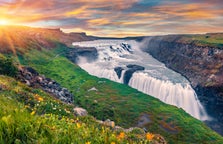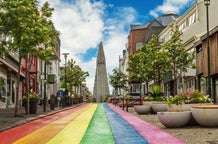Siglufjörður Travel Guide

Siglufjörður is a town of about 1,300 people, located in North Iceland. It is the northernmost town of the mainland.
The best way to visit the town of Siglufjordur is on a relaxed self drive tour. One of the best options for doing so is this 7-day Arctic Coast Way self drive, available in the summer months.
Along with its natural beauty, it is a cultural hub, with an award-winning Herring Era Museum, Folk Music Museum and the Folk Music Festival that attracts ever more travellers every year. It's a charming town to explore so if you're planning to stay there, make sure to book accommodation in Siglufjörður.
Photo by Luciano Braga
Economy
Siglufjörður has one of Iceland's best harbours and the fishing industry has been the mainstay of the economy for a long time. Like with the rest of Iceland, in recent years services and tourism have become increasingly essential parts of the economy.
Since the tunnels through the fjord Hedinsfjörður opened in 2010, the town has become much more easily accessible to those travelling the Ring Road of Iceland or staying in the northern town of Akureyri. Thus, there has been a large increase in visitors over the past decade.
History & Culture
 Photo by Alena Timofeeva
Photo by Alena Timofeeva
Siglufjörður has an eventful history in its more recent years, seeing a quick rise in the early 20th Century from being a tiny village to becoming an established town by 1918. By the middle of the 20th century it was one of the largest settlements in Iceland.
From this period, it was the capital of herring fishing in the North Atlantic, and the town's fishing museum bears proud witness to this history. Here, you can learn all about how important the seas were to the survival of all Icelanders from settlement to modernisation.
Called the Herring Era Museum, it is one of Iceland's largest seafaring and industry museums in the country. It is split into three houses; in one, you can learn about the fishing itself and the national processing processes. In another, you can see many ships and boats from the 1950s. The salting station retains the old look of the place and on good summer days travelers may observe the salting process in action.
Finally, the old Grana factory shows how herring was transformed into meals and oil.
The Folk Music Center is another cultural centre, located where the reverend Bjarni Þorsteinsson, 'The Father of Siglufjörður', lived. Here, the the old folk songs are brought to life, and you can hear recordings of people singing quint songs, called tvisongur; chanting the epic rhymes, or rimur; playing the langspil; and singing the old Icelandic nursery rhymes.
The centre also depicts the life of reverend Bjarni.
The Folk Festival
In early July, Siglufjörður hosts it annual Folk Music Festival, including the folk music of various nations, but with a special focus on Icelandic folk music. Various events take place, including lectures and courses on music and handicraft, along with dances, concerts and parties.
Nature
Siglufjörður is located in a particularly beautiful fjord of the same name, and high and dramatic mountains tower over the town. The birdlife is varied, with some 2,000 birds of 16 to18 species usually be found in the fjord, particularly in summer.
Popular hiking trails include the passes Hólsskarð and Hestskarð, which lead to the beautiful fjord Hedinsfjörður, which may also be accessed by boat or car.
The deserted Hedinsfjörður is surrounded by steep and impressive mountains and has a beautiful valley with good trout fishing in the Héðinsfjarðarvatn lake.
The last farm here, of Hedinsfjörður, was abandoned in 1951. In the 20th Century, there were usually five inhabited farms in the fjord, as the vegetation in the region is rich and food could be obtained from land and sea. The winters were hard, however, the area saw many avalanches, and the fjord was also hard to reach, so none remain.
Northeast of Hedinsfjörður you'll find the remnants of one of the remote farms in Iceland, Hvanndalir. Hvanndalir can be reached from Hedinsfjörður, though we would only suggest this route to seasoned hikers, accompanied by professional guides, as it goes over a collapsed mountainside.
Attractions Nearby
Popular categories

Download Iceland’s biggest travel marketplace to your phone to manage your entire trip in one place
Scan this QR code with your phone camera and press the link that appears to add Iceland’s biggest travel marketplace into your pocket. Enter your phone number or email address to receive an SMS or email with the download link.


















